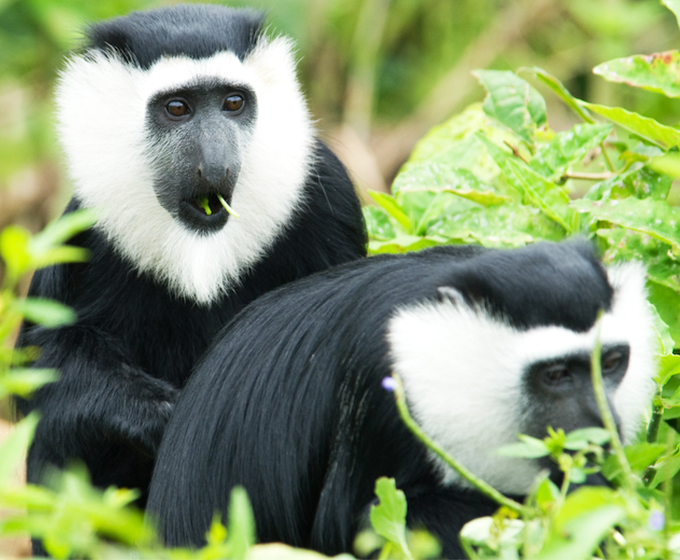
Wikberg’s research looked at transmission of microbes among colobus monkeys in Ghana.
MAY 7, 2020 — Microorganisms living inside and on our body play a crucial role in both the maintenance of our health and the development of disease. Now researchers at UTSA have uncovered evidence about the importance of maintaining physical distance to minimize the spread of microbes among individuals.
The scientists observed monkeys in the wild to understand what role genetics, diet, social groupings and distance in a social network play when it comes to the microbes found inside an animal’s gut.
“Social microbial transmission among monkeys can help inform us about how diseases spread. This has parallels to our current situation in which we are trying to understand how social distancing during the COVID 19 pandemic and future disease outbreaks may influence disease transmission,” said Eva Wikberg, an assistant professor in UTSA’s Department of Anthropology who studies the interaction between ecology, behavior and genetics in primates.
The gut microbiome refers to all the microorganisms inhabiting the digestive tract, starting with the stomach and ending with the colon. Over the past decade the microbiome has come under more scientific focus because it’s believed that an unhealthy gut microbiome can lead to obesity, impaired immune function, weakened parasite resistance and even behavioral changes.
However, researching microbiomes is difficult because of the variation in microbial composition between individuals. One long-standing question is whether this variation is driven by genetic makeup, diets or social environments.
This research inquiry has been especially hard in wild populations because of the lack of detailed data necessary to tease apart the myriad factors that shape the microbiome.
To find an answer, Wikberg and fellow researchers studied the fecal matter of 45 female colobus monkeys that congregated in eight different social groups in a small forest by the villages of Boabeng and Fiema in Ghana. The scientists saw major differences among social groups’ gut microbiomes.
However, individuals from different groups that were more closely connected in the population’s social network had more similar gut microbiomes. This discovery indicates that microbes may be transmitted during occasional encounters with members of other social groups.
A similar setting may be when people come into one-meter proximity of each other at a store. Being in close proximity or accidentally brushing up against someone else may be all it takes to transmit certain microbes.
This study suggests that microbes transmitted this way help the colobus monkeys digest the leaves in their diet. However, further research is needed to investigate whether this type of transmission yields health benefits, which could explain why different social groups occasionally have friendly between-group encounters.
“Studies of wild animals can teach us a lot about the importance of using interventions, such as social distancing, to ensure a safer community during this pandemic,” said Wikberg.
The study’s findings are reported in the May issue of the journal Animal Behaviour.
Wikberg’s other research collaborators are Diana Christie and Nelson Ting, of the Institute of Ecology and Evolution at the University of Oregon, and Pascale Sicotte, of the Department of Anthropology and Archaeology at the University of Calgary.
UTSA Today is produced by University Communications and Marketing, the official news source of The University of Texas at San Antonio. Send your feedback to news@utsa.edu. Keep up-to-date on UTSA news by visiting UTSA Today. Connect with UTSA online at Facebook, Twitter, Youtube and Instagram.
Move In To COLFA is strongly recommended for new students in COLFA. It gives you the chance to learn about the Student Success Center, campus resources and meet new friends!
Academic Classroom: Lecture Hall (MH 2.01.10,) McKinney Humanities BldgWe invite you to join us for Birds Up! Downtown, an exciting welcome back event designed to connect students with the different departments at the Downtown Campus. Students will have the opportunity to learn about some of the departments on campus, gain access to different resources, and collect some giveaways!
Bill Miller PlazaJoin us for an intimate evening of cocktails, conversation, and culinary inspiration with Pati Jinich, Emmy-nominated chef and James Beard Award-winning author. Enjoy light bites and signature drinks in the warm, modern setting of Mezquite as Pati connects with guests over her passion for Mexican cuisine and storytelling.
Mezquite Restaurant in Pullman Market, 221 Newell Ave., San Antonio 78215From inspired courses to thoughtful pairings and a rich sense of community, the Ven a Comer Signature Dinner is a night of shared meals, shared stories, and unforgettable flavor.
Stable Hall (Pear Brewery), 307 Pearl Pkwy, San Antonio 78215Come and celebrate this year's homecoming at the Downtown Campus with food, games, giveaways, music, and more. We look forward to seeing your Roadrunner Spirit!
Bill Miller PlazaThe University of Texas at San Antonio is dedicated to the advancement of knowledge through research and discovery, teaching and learning, community engagement and public service. As an institution of access and excellence, UTSA embraces multicultural traditions and serves as a center for intellectual and creative resources as well as a catalyst for socioeconomic development and the commercialization of intellectual property - for Texas, the nation and the world.
To be a premier public research university, providing access to educational excellence and preparing citizen leaders for the global environment.
We encourage an environment of dialogue and discovery, where integrity, excellence, respect, collaboration and innovation are fostered.